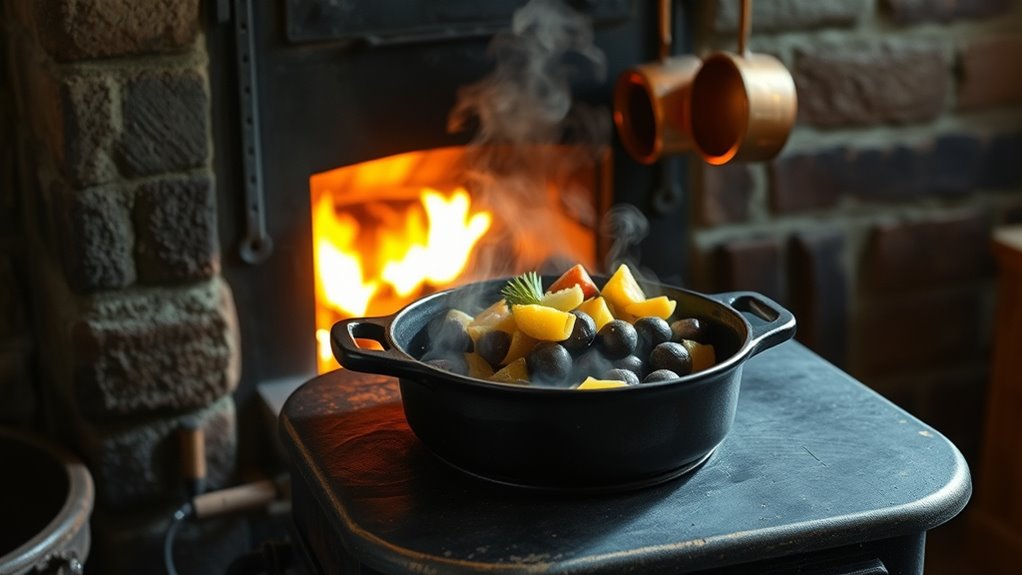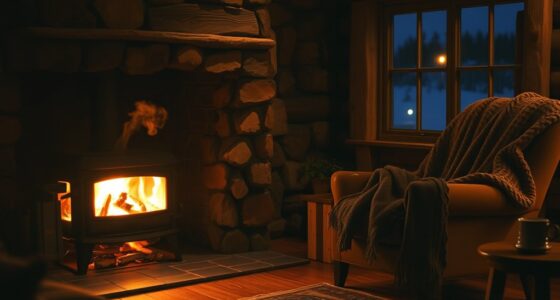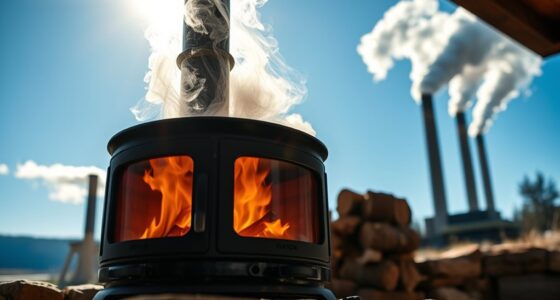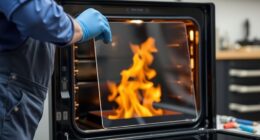Yes, you can definitely cook on your wood stove, as it’s a versatile tool that allows you to prepare a variety of meals. When properly installed on a fire-resistant surface and maintained regularly, it offers excellent heat control for baking, boiling, simmering, and more. Managing airflow and adding wood carefully lets you regulate temperature for different dishes. Curious to discover tips on mastering fire control and making the most of your wood stove? Keep exploring to learn more.
Key Takeaways
- Yes, wood stoves can be used for cooking with proper heat control and suitable cookware.
- Cast iron pots and pans are ideal for even heat distribution on a wood stove.
- Managing airflow and adding wood regulates temperature for boiling, simmering, or baking.
- Ensure your wood stove is installed properly and maintained for safe cooking.
- Practice fire management skills to achieve consistent cooking temperatures.

Have you ever wondered how cooking on a wood stove differs from using modern appliances? When you start exploring this traditional method, you’ll quickly realize it’s a unique experience that combines skill, patience, and a connection to the past. One of the most important aspects to consider is wood stove safety. Unlike electric or gas stoves, a wood stove requires careful handling of fire and heat to prevent accidents. Always guarantee your stove is properly installed on a fire-resistant surface, and keep a fire extinguisher nearby just in case. Regular maintenance is vital—clean out ashes frequently, and check for any signs of wear or damage, especially around seals and vents. Proper ventilation is indispensable to avoid buildup of dangerous fumes, so make sure your stove’s chimney is clear and functioning well. These safety measures help you enjoy traditional cooking techniques without risking harm to yourself or your home.
Cooking on a wood stove involves mastering traditional techniques that have been used for generations. Unlike modern appliances with precise temperature controls, you’ll rely on your skill to regulate heat through the amount of wood you add and how you manage airflow. For example, to simmer or slow-cook, you might push the fire to one side, creating a cooler zone, while for boiling or frying, you’ll need a hotter, more active fire. This process teaches you to read the stove’s heat levels intuitively, developing a deeper understanding of how different woods and burning methods influence temperature. Using cast iron pots and pans is common because they hold heat well and distribute it evenly, making them ideal for traditional cooking techniques. You’ll also learn to adjust the damper and air vents to control the intensity of the fire, which is a skill that takes practice but offers a satisfying sense of control. Additionally, understanding the role of soulmates and destiny can add a layer of mindfulness and emotional connection to your cooking experience.
Cooking on a wood stove isn’t just about preparing food; it’s about reconnecting with a time-tested method that emphasizes patience and attentiveness. It requires you to plan ahead, start your fire early, and stay engaged throughout the process. This method fosters a mindful approach to cooking, reminding you of a simpler, more sustainable way of living. As you become more confident, you’ll find that this technique allows for versatile meal preparation—baking bread, roasting meats, or simmering stews—all with the charm of traditional methods. Embracing wood stove cooking means embracing a lifestyle that values safety, skill, and a deep respect for the craft of traditional cooking techniques.
Frequently Asked Questions
Can I Use My Wood Stove for Baking?
Yes, you can use your wood stove for baking, making it perfect for homemade bread and other baked goods. To do wood stove baking, position your dough on a heat-safe surface inside the stove, using the residual heat to bake. Keep an eye on the temperature, and adjust your wood fire as needed. With some practice, you’ll master wood stove baking and enjoy delicious homemade treats right from your stove.
How Do I Control the Temperature While Cooking?
You can control the temperature on your wood stove by making stove adjustments. For example, if you’re simmering a stew and it gets too hot, gently adjust the damper to reduce airflow, lowering the temperature. Conversely, increasing airflow with the damper raises the heat. Monitoring your stove’s heat and learning how different wood types burn helps you master temperature control, ensuring ideal cooking results every time.
Is It Safe to Cook With Water on a Wood Stove?
Yes, it’s safe to cook with water on your wood stove if you follow fire safety and maintain your stove properly. Always keep the area clear of flammable materials, monitor the stove while in use, and make sure your chimney and vents are clean to prevent smoke buildup. Regular stove maintenance helps avoid dangerous creosote buildup and ensures even heat distribution, making your cooking safe and effective.
Can I Cook All Types of Food on a Wood Stove?
You can cook a wide variety of foods on your wood stove, but keep food safety in mind by avoiding cross-contamination and ensuring proper cooking temperatures. Wood stoves are energy-efficient, providing consistent heat for baking, simmering, and frying. However, some delicate dishes or precise recipes may be tricky. Use appropriate cookware, monitor temperatures, and clean your stove regularly to maintain safety and maximize energy efficiency.
What Cookware Is Best for Wood Stove Cooking?
You should choose durable cookware like cast iron for wood stove cooking. Cast iron offers excellent heat distribution, which helps prevent hot spots and guarantees even cooking. Its ability to retain heat makes it ideal for simmering, frying, and baking on your stove. Plus, cast iron is versatile and long-lasting, making it a reliable choice for all your wood stove culinary adventures.
Conclusion
Absolutely, you can cook on your wood stove, turning it into a heartfire that warms both your home and your soul. Think of it as a dance between flame and flavor, where each meal is a step closer to tradition and comfort. Embrace the crackle and glow, knowing you’re not just cooking—you’re weaving memories into the very fabric of your cozy sanctuary. Let your stove be the steady beat of your home’s comforting rhythm.











